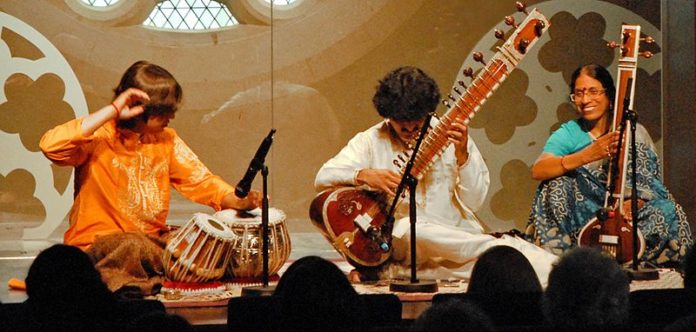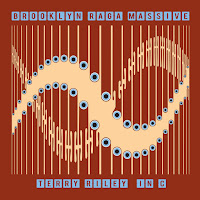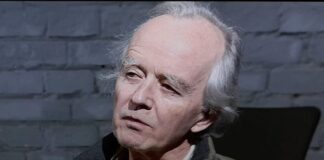
Some currents of avant-garde music in the West during the second half of the last century drew inspiration from the sounds and forms of Indian classical music. As with previous, non-musical Western avant-gardes—one thinks of Cubism’s interest in African sculpture, or the Surrealist fascination with the plastic arts of indigenous Mexico and Oceania—composers and improvisers in Europe and America found stimulation and a certain degree of direction from a tradition at a more-or-less distant remove from their own. And yet through a certain kind of immanence in which elements of the one would be contained within the other, the more successful experiments produced a music of confluence rather than collision.
Brooklyn Raga Massive, a large collective of musicians conversant with classical raga as well as with Western music, is a contemporary ensemble continuing the dialogue between Indian and Western music. Two recent releases are particularly engaging for the way BRM have taken the raga influences implicit in or hinted at by two figures of the 1960s avant-gardes and made them explicit, integral forces through which their music can be interpreted.
Terry Riley’s classic work In C, which debuted in 1964, is a highly flexible piece that has been adapted to many different situations and instrumental combinations of different sizes. It has been realized by ensembles made up of various combinations of Western orchestral instruments; has been played in ensembles for a single type of instrument, including Stefano Scodanibbio’s magnificent arrangement transposed to D for nine double basses; it has been played by guitar ensembles and has even been played by solo trombone with electronics. Further afield of Western instrumentation, the piece has been arranged for a mixture of Western and non-Western instruments, as well as for traditional Chinese and African instruments. BRM’s recording of In C, taken from a January 2017, performance, offers an arrangement of the piece for Western, Indian and Middle Eastern instruments that includes sitar, oud, bansuri, vocals, tabla, hammered dulcimer, violin, cello, double bass, dragon mouth trumpet, guitar, cajon, riq and frame drum. In consultation with the composer, BRM developed an interpretation that preserved the essence of the piece as written while adding elements that draw on the improvisational conventions of raga.
As composed, In C integrates improvisation into its very structure. The score is simple—a single sheet containing 53 cells, each of which consists of a brief phrase without markings for dynamics or articulation. Performers are to play the cells in sequence, repeating each one as long as desired before moving on to the next. The quasi-random overlapping of parts gives the piece a shimmering, phasing quality. Although most of the cells are based on a C major triad, others imply E minor, G major or G minor tonalities; these changes of implicit harmony proceed very slowly and—in most performances–on top of a repeated C note, thus making themselves felt more as changes of color within a C major chord rather than as shifts of tonal center. (Although Riley recommends that performers stay within two or three cells of each other, it isn’t unusual for performances to slip; besides adding an extra layer of chance to the realization, this creates interesting and unexpected synchronisms and harmonic ambiguities of its own.) In C’s feel of harmonic stasis aligns well with traditional raga’s limitation to a single harmony, and so hearing the piece played with raga as a point of reference requires little suspension of any disbelief the listener may initially bring to BRM’s performance.
Brooklyn Raga Massive go beyond the standard interpretation of In C by adding an introductory alap at the beginning of the piece, and a jhalla to close it. Although the alap is brief—exceedingly so, by ordinary raga standards—it sets the tone for what will follow. What follows is a colorful reading of Riley’s composition enhanced by embellishments of, or solos over, the basic cells. The addition of the solos came at Riley’s suggestion, and who better to make the suggestion than the composer, who himself studied classical Indian vocal music for many years with Pundit Pran Nath? The solos offer a brilliant, and perfectly apt, ornamentation to the melodic fragments contained in the cells. The bansuri solo over cells 12-13 begins a string of solos that include energetic improvisations by oud, violin, sitar and voice; each soloist elaborates and develops the fundamental kernels of the cells in an entirely natural way. The soloists’ incorporation of microtonal embellishments—the notes between the notes characteristic of raga—add an intriguing shade of chromatic nuance to Riley’s basic harmonic structures. Similarly, subsequent solos for percussion bring a welcome rhythmic complexity to the underlying pulse. In fact the percussion instruments—particularly the tablas—play the crucial role of anchoring the piece, usurping the role ordinarily taken by a repeated C played on keyboard.
One of the beauties of In C is that there is no canonical version. The score doesn’t specify the size or makeup of the ensemble, leaving the piece open to the most imaginative interpretive possibilities. Brooklyn Raga Massive’s interpretation shows just how rich these possibilities can be.
Like their In C, the ensemble’s Coltrane Raga Tribute addresses the work of an artist whose sensibility was profoundly influenced by the modalism and extended improvisations of raga. The release takes eight pieces by John Coltrane and one by Alice Coltrane and orchestrates them for a combination of instruments somewhat different from that used in In C. On BRM’s version of India—certainly a natural choice to interpret—the jazz element predominates, particularly in the rhythm section’s drive and makeup. As with the augmented 1961 John Coltrane Quartet that originally recorded India, the drums and piano are the pivot on which the piece balances, but the alap-like introduction for bansuri and droning bass that takes up nearly a quarter of its length unmistakably demonstrates the correspondences between Coltrane’s composition and the sources that inspired it. Alice Coltrane’s Journey in Satchidananda, the title track from the classic 1971 album, is played close to the original and no wonder: many of the possibilities opened up by a more explicit crossing of jazz and raga were explored in that recording. BRM takes it one step beyond, though, in featuring a rich solo for sitar; the solo for a hard-rock toned electric guitar that follows somehow sounds perfectly fitting. Similarly, BRM ‘s interpretation of Alabama includes a fine sarod solo over tabla and comping by electric guitar.
Both In C and the Coltrane Raga Tribute show that the attempts during the 1960s to shape Western music around some of the materials, forms and conventions of raga were more than the passing fads of a decade rich in passing fads; they instead opened a field that continues to reward exploration.








